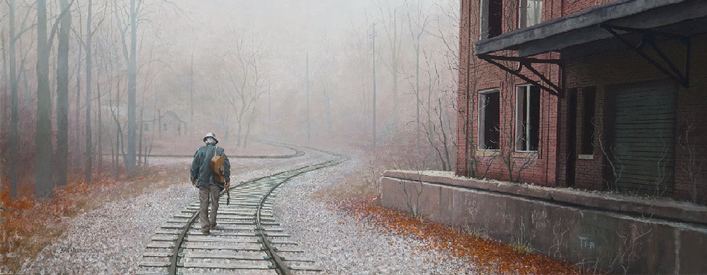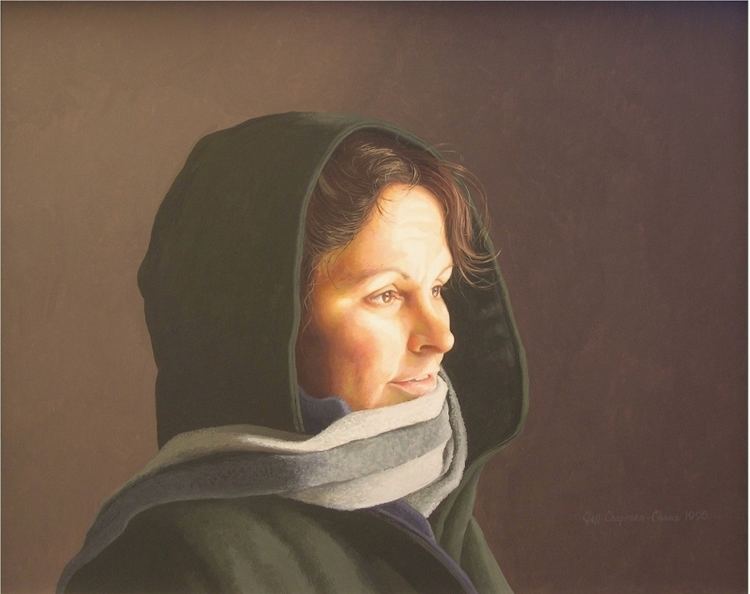Occupation Painter and sculptor Nationality American | Name Jeff Chapman-Crane | |
 | ||
Genre gouache, egg tempera, watercolor | ||
A day with jeff chapman crane
Jeff Chapman-Crane (born 1953) is an Appalachian artist and American realist. Primarily recognized as a painter, his preferred media are gouache, egg tempera, and watercolor. He is also known for his sculptural work. His illustrations have appeared on the covers- and within the pages- of literary works. His art has also been utilized in non-profit activist campaigns. Crane's work has appeared in multiple venues, but he is mainly promoted by two galleries: Phyllis Weston, Cincinnati, Ohio and J.N. Bartfield Gallery, New York, New York His family's personal gallery, Valley of the Winds, which he runs with his wife, Sharman Chapman-Crane, has been recognized by the state of Kentucky as a tourism destination.
Contents
- A day with jeff chapman crane
- Biographical background
- Artistic background
- Evolution of media preference
- Style influence
- Artistic focus
- Gallery affiliation exhibits and awards
- Book covers
- Broad form deed
- The Agony of Gaia
- References

Biographical background
A lifelong Appalachian, Chapman-Crane is a native of Kingsport, Tennessee. Born in 1953, he was the third of four children, and the only boy in the bunch. He reported in an interview with the East Kentucky Art Project that he spent part of his childhood exploring the woods near his home. He credited his youthful connection to the land, and his experience with negative Appalachian stereotypes as influencing his artistic focus.
He moved to Kentucky in 1982. After presiding in Neon, Kentucky, for a couple of years, he moved to Eolia, Kentucky on Pine Mountain in Letcher County. He lives there with his wife, Sharman Chapman-Crane whom he married in 1984. The couple produce artwork which they showcase in their on-site gallery, Valley of the Winds. The artwork of their son, Evan Chapman-Crane, is also on display.
Artistic background
Chapman-Crane is the first member of his family to delve into this line of work. In spite of this, he told journalists that he felt an artistic sense of direction from an early age. His only formal training was four years of high school art classes under his teacher- and later, mentor- Don Hilton. He credits Hilton as having a significant influence on his artistic growth. Chapman-Crane began his actual career in the arts in 1974. He moved to southeastern Kentucky in 1982. Throughout his career, he has produced Appalachian inspired artwork, focusing on the local area and people, in particular.
Evolution of media preference
As a painter, his chosen media has evolved over the years. His early work featured a lot of pastel paintings, particularly portraits. When he progressed from student artist to professional painter, he began to focus on watercolor, a medium that he still employs. He later added gouache- an opaque watercolor- to his toolbox. He dabbled in acrylics, but as with oil, he never felt comfortable with it. He also explored casein. Along with watercolor, casein comprised most of Chapman-Crane's earlier professional pieces. He later developed an allergy to casein, which prompted him to replace those paints with egg-tempera. He was initially remiss to use that medium because he thought it would strengthen his style's resemblance to the work of artist, Andrew Wyeth. Having been previously compared to the painter, he wanted to distinguish his look from the work of his predecessors. He did acknowledge that Wyeth had made an impression upon his work, however. Chapman-Crane eventually came to integrate the new medium into his body of work.
Style influence
The artist credits his teacher, Don Hilton, with having an immeasurable influence on his work. He has also been inspired by Rembrandt and the old masters, but says that Vermeer's paintings were paramount among the classical creators in shaping his personal style. As for contemporary painters, Andrew Wyeth and other American realists have impressed themselves on Chapman-Crane and his artistic vision. Vincent Van Gogh is Chapman-Crane's favorite artist, but he acknowledges that their style is completely unrelated to one another. The expressionist's "passion and...the emotional intensity of his work," appealed to Chapman-Crane. He has not emulated the appearance of his art, though. While Van Gogh used expressive brush strokes with thick textural paint, Chapman-Crane's work is more restrained. His paintings are not highly textural, but more 2-D in nature. His brush strokes have been described as being relaxed, yet showing restraint. One reporter described a "sure, light and economical brushing technique" on his landscapes. His creations do not have the wild motion of Van Gogh whose work exudes energy. Chapman-Crane's subjects are more often in repose. Van Gogh also played with color, using unnatural and vivid hues. Chapman-Crane's color usage has been described as being more subdued. Words such as "stark," "matte," and "cool and muted," have been applied to his use of color and shadow. However, this should not be taken to mean that the works lack light and warm hues. One writer noted that some of Chapman-Crane's paintings of children showed them in the sun. Also, while his color is not dramatic, his lighting has been compared to that of the Baroque painters.
Artistic focus
The content of Chapman-Crane's work includes people, landscapes, and buildings and other elements of the Appalachian region.
Gallery affiliation, exhibits, and awards
Chapman-Crane is currently promoted by Greenwich House Gallery, Cincinnati, OH and J.N. Bartfield Gallery, New York, NY. He was previously affiliated with another gallery in New York. Paul Young, previously of New York (now deceased) was Chapman-Crane's art agent. The artist's work has appeared in various venues including galleries, universities, churches, festivals, activist events, on literary works, etc.
Chapman-Crane has repeatedly received awards from the Virginia Highlands Festival's Juried Art Show in Abingdon, Virginia. His Abingdon awards include the "Award of Excellence," "Award of Merit," and "Best in Show/People's Choice." Ragsale," a children's book illustrated by the artist, won a "Best in Show" award at the 1995 New England Book Fair. He was also a four time finalist of the Artists Magazine portrait competition.
Book covers
Chapman-Crane's work has appeared on various literary covers and pages within publications. His art wrapped the words of Ann Pancake's novel, "As Strange as This Weather Has Been," Artie Ann Bates' children's book, "Ragsale," Jenny Galloway Collins' book, "Ember Days," and a book of poems by Cranston Stroup called "Give God a Flower." "Ragsale" won the New England Bookfair's award for "Best in Show," and Louisville, Kentucky's Bernheim Arboretum Purchase Award. In addition to books, Chapman-Crane's art work appeared on the cover of the 17th edition of the journal, "Pine Mountain Sand and Gravel," and the program for the 16th Annual Festival of Faith in Louisville, Kentucky. His art also appeared in the October 1986 edition of American Artist Magazine, along with his instructions for painting with casein.
Broad form deed
Chapman-Crane's art has been used in two activist campaigns. During a push to end the broad form deed, the grass roots organization, Kentuckians for the Commonwealth, utilized a print by Chapman-Crane in their advertisements. The image showed a sillhouette of a bulldozer headed towards a simple house with the caption, "Save The Homeplace. Stop abuses of broad form deeds." That campaign ended in 1988 when the practice was outlawed.
The Agony of Gaia
More recently, Chapman-Crane's mixed media sculpture, The Agony of Gaia, has been used to promote awareness about Mountain Top Removal Mining in the Appalachians. It was unveiled in 2004 at a meeting of Kentuckians for the Commonwealth. The sculpture had been at more than 50 venues as of December 2011. It has been used to attract attention to the issue in the form of book covers, a billboard, and through making appearances at campuses, churches, and activist events. It also had a presence at a United Nations hearing.
The work took over 16 years to complete. The hands and face are made of clay, and the body of lightweight refurbished Styrofoam and paint. Moss, toy vehicles, and other elements have been used to add details. Looking at the sculpture, it is clear why the artist chose this title. Gaia is a Greek goddess who represents "mother earth". This piece depicts the earth as a woman whose flesh forms a strip mined mountain. The figure is reclined on her side in a fetal position. Her clenched hands are clasped to her face, as tears stream through her fingers, they form a forest stream. Watery tears run in resin by the landscape of her body. The contours of her curves attempt to capture the restless Appalachian landscape. The topography of terra and woman descend at her waist in the dip of valley or "holler," and rise with her hips in the detail of a mountain. Mixed media commingle in a show of contrast and connection. The contrast can be seen in the piece's progression from left to right. The left of the work depicts an untouched environment. Green trees spring from her upper body, as moss clings to the cliff of her arms. As the work travels right, the woman's body is bare and barren, as though clear cut. Her flesh has been carved into, as evidenced by an exposed coal seam, crumbling ground at the end of her arms, and the rocky ridge of naked ribs which jut out like cleaved stones. Red streams pour down from the broken "ribs" possibly representing a comparison between blood and water tinged by oxidized minerals. Mining equipment, such as draglines, can be seen traversing the exposed portion of Gaia's body. The background of the work- which depicts the artist's rendering of a sky- progresses in a similar fashion from left to right. The left hand side presents a light blue sky with a smattering of clouds, and mountains at the bottom. On the right hand side, the number of clouds has increased to such an extent that they occlude the sky. The color of the clouds also grows increasingly dark, turning from a color which could be described as primarily white, to one that is dark gray or light black. A poem penned by the artist has been placed across the bottom of his piece. From left to right it migrates from the natural to the mechanical, the untouched to the "unreclaimed".
The Agony of Gaia made its first cover appearance on Ann Pancake's novel, "Strange as this Weather Has Been". The cover image of the sculpture was snapped by photographer, James Archambeault. More recently, Gaia's image wrapped the frame of the journal, Pine Mountain Sand and Gravel.
